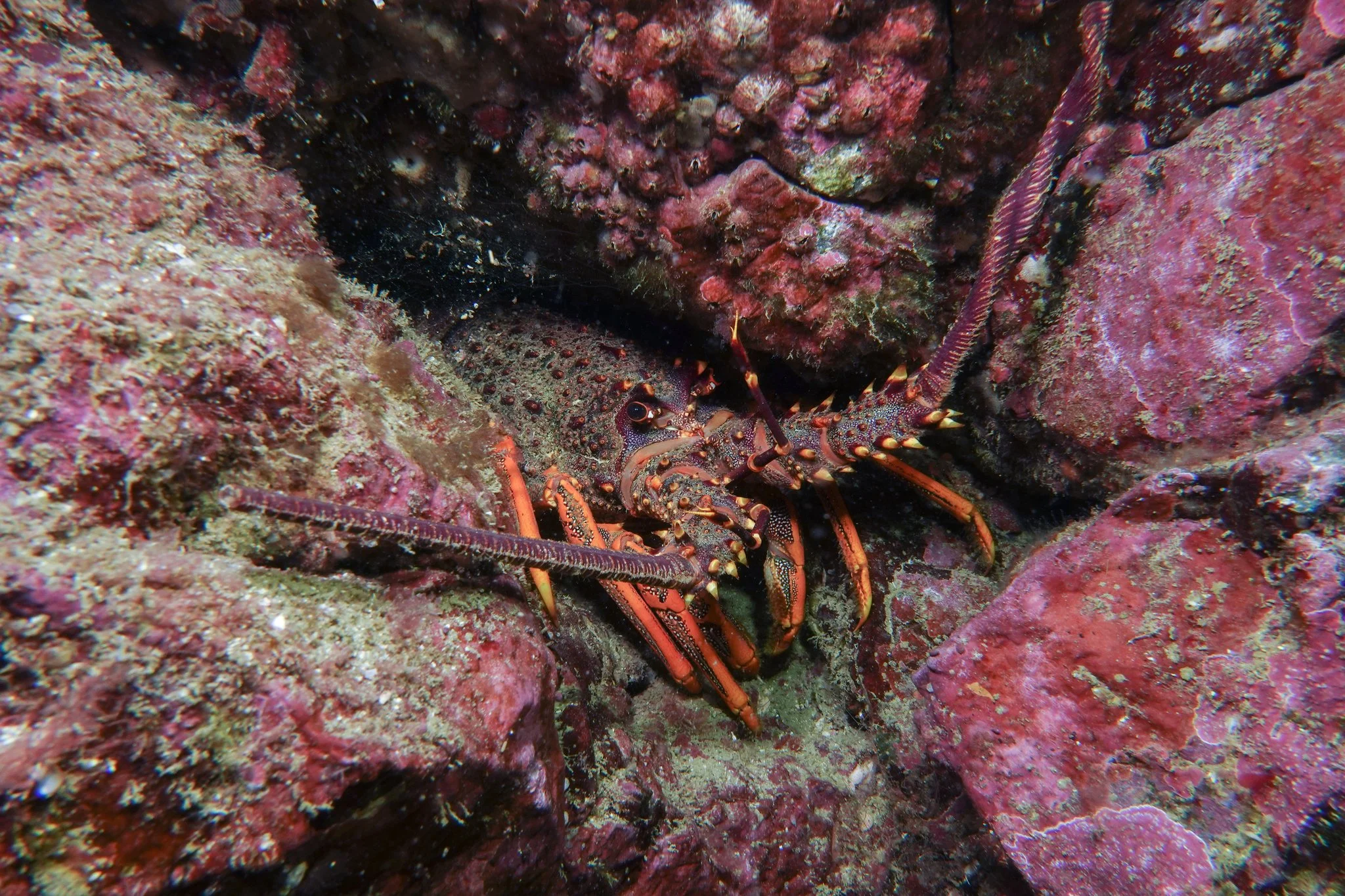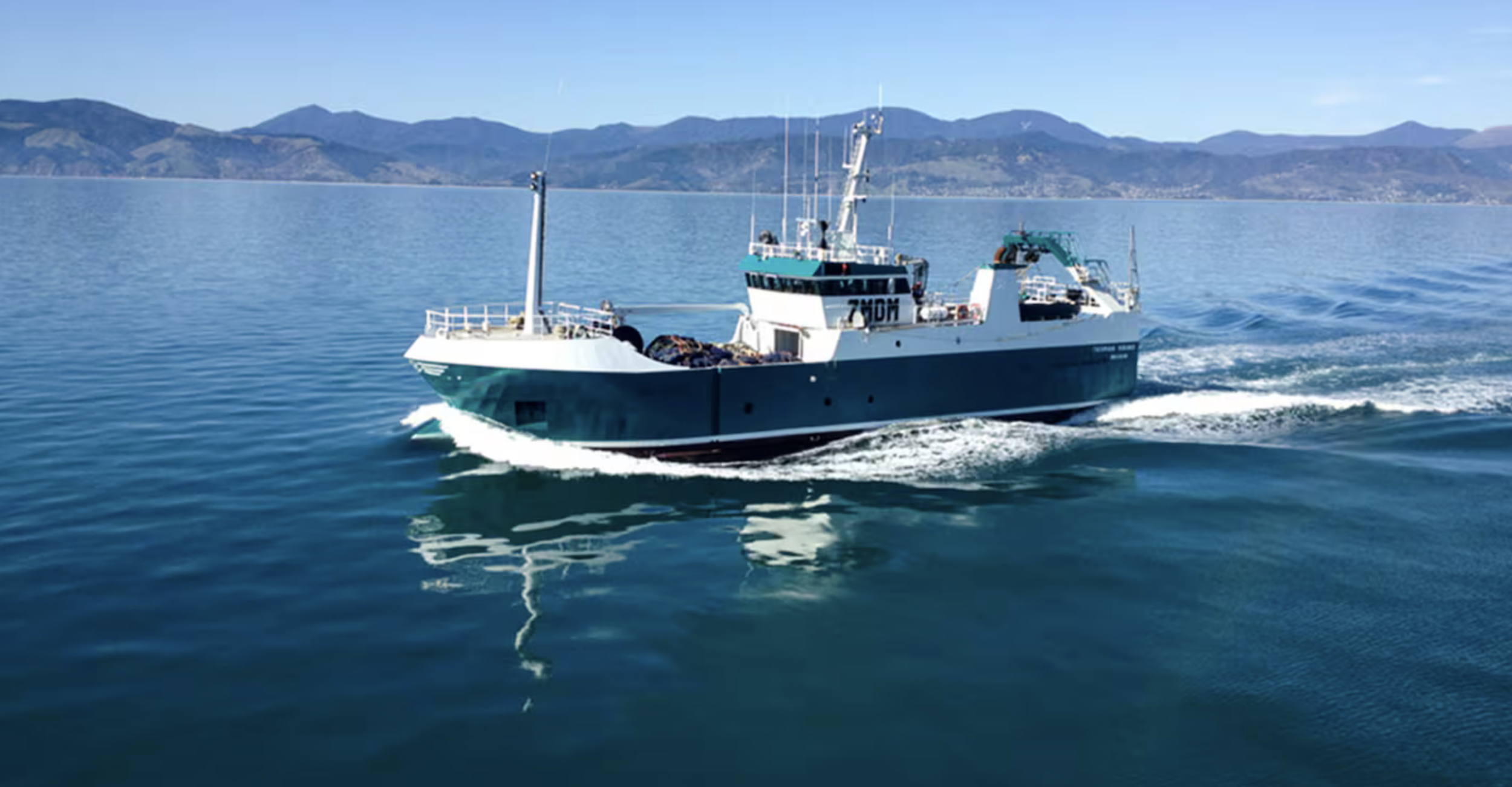EDITORIAL: Sailing close to ecological collapse in Tikapa Moana / Te Moananui-a-Toi
KATE WATERHOUSE (Chair of AGBET)
Rock lobster (Jasus edwardsii) (Credit: lcolmer/iNaturalist)
“After living for nearly a hundred years on this planet, I now understand that the most important place on Earth is not on land, but at sea.”
Ocean with David Attenborough is an absolutely stunning documentary. Through groundbreaking cinematography and the authoritative voice of Attenborough, the film reveals to us some of the Earths’ most spectacular underwater habitats but also shines a light on the plight of the ocean from destructive human practices. The documentary is anchored in science and narrated in the deeply personal, reflective Attenborough way, who at the remarkable age of 99 shares with us not only the beauty of the ocean but also the ways in which humans are destroying it. The film is visually spectacular but also heartbreaking as the impact of industrial scale fishing and seabed dredging is revealed. The scenes of dredging across seabed structures that have taken thousands of years to form was the most confronting.
My 12-year old grandson struggled to understand why some humans would engage in such destructive practices. Launched on World Ocean Day this year, the documentary has a strong message of hope from Attenborough because the sea has shown a great capacity to recover if left alone to do so. But he makes a plea for us to heed the warnings and take action to protect the ocean.
New Zealand, as a signatory to the United Nations Convention on the Law of the Sea (UNCLOS) 1982 agreement, has obligations to protect and preserve our ocean1. In that year we became guardians of an additional 4.3 million sq km of ocean territory, the 4th largest in the world. In December 2022, the government signed up to another ambitious and far-reaching agreement; the Global Biodiversity Framework 2030, which commits us to protecting 30% of our marine environment by 2030, a target we are well short of with just 0.4% of our ocean territory currently protected. Research has shown that 30% is the minimum level of protection needed to keep the global ocean healthy and productive for future generations(1).
Now the proposed Hauraki Gulf/Tīkapa Moana Marine Protection Bill is paused. If passed it will establish 12 new High Protection Areas (HPAs) that allow for customary access within locally agreed biodiversity limits, in line with Article 2 of Te Tiriti o Waitangi. But even then, only 6% of the marine park will be protected – including some of the waters around the Mokohinau group.
But Aotea’s moana still has no legal protection and will get none under the proposals. The island was also left out of proposals in the 2017 Sea Change report and instead was identified as an Ahu Moana pilot site. Ahu Moana is an approach to local fisheries management by iwi and communities. It is underpinned by regular local monitoring of the health of the environment. This sounded good in principle but came with no support or resources from MPI to implement. Though through the efforts of Ngāti Rehua-Ngātiwai ki Aotea, the Aotea Great Barrier Local Board, marine biologist Glenn Edney and the Schooner Bay and Motairehe communities over the last 3 years, a way of monitoring and managing coastal waters may still emerge.
The Tasman Viking fishing trawler operated by Westfleet Seafoods of Port Nelson that has been responsible for two cases of dredging coral on the Lord Howe Rise
So many of our fisheries have been managed in ways that leads to collapse of the fishery followed by crisis action to deal with a situation that should never have arisen. A good example of this is the decision in April 2025 to ban harvest of crayfish/kōura in the inner Hauraki Gulf(2). While this decision was welcome, the population had already declined to the point it was not commercially viable before this change. In making a submission on this fishery we were shocked to discover that the methodology used by Fisheries New Zealand to determine crayfish populations is flawed(3), highlighting the need for regulation to be underpinned by robust science. It is still crayfishing as usual at Great Barrier Island and Aotea is now under huge pressure from both commercial and recreational fishing with no management options such as seasonal closure for breeding. The breeding season is approximately six to seven months, from April through to September. Protecting kōura at this time is essential for a healthy population. Other management options for Aotea include no take areas, reduced daily recreational bag limits, maximum recreational size limits, maximum boat limits, banning the use of scuba for harvesting kōura and a minimum depth limit for pots(4). Community research is underway to understand local perspectives on this – once again iwi and local board members are leading the way.
In Te Moananui o Toi, the outer Hauraki Gulf, no one wants to see more loss of the Carpophyllum and Eklonia kelp forests from overgrazing by kina/sea urchins, which is linked to overfishing of their predators; crayfish/kōura and large snapper/tāmure(5). Marine heat waves and exotic caulerpa infestations are adding further stress to reef systems. But MPI’s proposals in the recent amendments to the Fisheries Act 1996 will further weaken science-based decision making.
Poor fishing practices by the industry are not limited to New Zealand’s Exclusive Economic Zone. Last year a New Zealand vessel was found to have dredged up coral in international waters at the Lord Howe Rise, a largely unexplored deep-sea plateau, which is home to hundreds of fish species(6). The same vessel was fined for a similar incident in 2023. New Zealand is the only country still bottom trawling in the South Pacific high seas(7). The contribution by New Zealand of $10 m to a global fund for coastal coral reef protection is a hollow commitment from our government(8).
Marine abundance at Goat Island (Credit: Goat Island Dive & Snorkel)
Meanwhile bottom trawling also continues around Aotea, scallops have collapsed, and daily limits for recreational fishers continue to allow removal of too many fish. Eleven years after the beginning of the Sea Change process, the only protection of Aotea’s waters has been through rāhui, and the unintentional reduction of boat numbers through COVID and the imposition of an anchoring ban inside controlled areas on Aotea’s west coast, to stop the spread of exotic caulerpa.
What continues to be left out of the conversation is what we all stand to gain by following the proven customary management practices of tangata whenua and setting aside areas to recover. Research from Goat Island marine reserve clearly demonstrates the positive “spillover” effects likely from this practice(9). If an area is closed, once fish populations recover, adult fish cross reserve boundaries and replenish surrounding areas, and the eggs from snapper and crayfish in particular, are spread on currents to other locations. Other research in Mexico and California shows that commercial fisheries adjacent to protected areas actually benefit. There is no loss of commercial catch.
What is missing locally is a willingness by government, commercial and recreational fishing interests to give up access to areas so that Aotea and Te Moananui o Toi can rest and recover. And it needs to be allowed to recover – climate change will warm seas, more La Niña seasons and possibly weakening East Auckland current reducing ocean productivity. A healthy marine environment has more resilience to invasive species, changing temperatures and fluctuations in food availability. It makes economic sense to set areas aside now, with appropriate recognition of the rights of tangata whenua under Article 2 of Te Tiriti o Waitangi. It’s the right thing to do for our grandchildren and the generations to come, who should not have to go to Goat Island to understand what a healthy reef and ocean abundance is like.
“Having been made guardians of the 4th largest marine territory in the world, it is time to honour our obligation to the United Nations community: To Protect and Preserve.”
References
Browen Golder 2023. The obligation to preserve and protect. Aotea Great Barrier Environmental Trust Environmental News #48, p 12-16.
Ministry for Primary Industries. Review of sustainability measures for fisheries – April 2025 round. Minister’s decisions released for rock lobster. https://www.mpi.govt.nz/consultations/review-of-sustainability-measures-for-fisheries-april-2025-round/
Nessia HR, Hanns BJ, Haggitt TR & Shears NT (2024). Using marine protected areas to assess the status and recovery of the spiny lobster Jasus edwardsii fishery in the Hauraki Gulf, Aotearoa New Zealand. Frontiers in Marine Science 11: 1440350.
Glenn Edney personal communication.
Miller K, Balemi CA, Bell DR, Blain CO, Caiger PE, Hanns BJ, Kulins SE, Ohad Peleg A, Spyksma AJP & Shears NT (2023). Large-scale one-off sea urchin removal promotes rapid kelp recovery in urchin barrens. Restoration Ecology 32. e14060.
Michael Morrah, NZ Herald, 1 Nov 2024. New Zealand trawler catches coral triggering fishing suspension in Lord Howe Rise. https://www.nzherald.co.nz/nz/new-zealand-trawler-catches-coral-triggering-fishing-suspension-in-lord-howe-rise/ NUOA42BZIVETNMUCQ7F6KDLENE/
Andrea Vance, Stuff, 28 Jan 2024. New Zealand backs away from deep-sea trawling restrictions. https://www.thepost.co.nz/ politics/350157805/new-zealand-backs-away-deep-sea-trawling-restrictions
New Zealand announces a contribution of $10 m to a global fund for coastal coral reef protection at the UN Biodiversity Conference (COP16) in Colombia, 31 Oct 2024.
Kate Evans, NZ Geographic. https://www.nzgeo.com/stories/taking-on-water/



